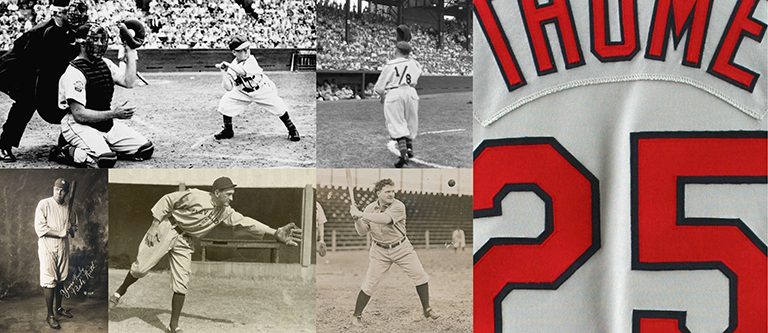We’re celebrating our 40th year. Did you know ball players didn’t always have numbers? I didn’t either.

Top left and center: Eddie Gaedel, the shortest player ever to take an at-bat in the majors sporting his number ⅛. Bottom left:An early portrait of Babe Ruth, Shoeless Joe Jackson in 1914, 1012 photo of popular Cleveland catcher Paddy Livingston. Far right: 1995 Jim Thome #25 Game-Worn Road Jersey that sold at auction for $600.
We’re so pleased to be celebrating our 40th year with you, we thought we’d give you some summertime baseball and Tribe “number trivia” to celebrate:
- The first time a Major League baseball team to wear numbers was on this day, June 26, 1916 by our very own Cleveland Indians. Inspired by football and hockey’s use of numbers, the Tribe trotted on their home field wearing large numbers on their left sleeves. This “experiment” was tried for a few weeks, again the next season, and then abandoned.
- 1923, the St. Louis Cardinals adopted uniform numbers on their sleeves. However, as then-manager Branch Rickey recalled, the Cardinals’ players were “subjected to field criticism from the stands and especially from opposing players,” – so the numbers were removed.
- In 1929, the New York Yankees and Cleveland Indians were planning to start the season with uniform numbers on the back of their jerseys. The Yankees were rained out on opening day, while the Indians played, making Cleveland the first MLB franchise to wear numbers on their back. (The Yankees debuted their numbered jerseys the following day.)
- The first MLB game to feature both teams wearing numbers on their jerseys was the game between the Indians and the Yankees on May 13, 1929.
- By the mid-1930s, all MLB teams wore numbers; in 1937 the Philadelphia Athletics finally began wearing numbers on both home and away jerseys, making numbers a universal trait in the MLB.
- The original baseball numbers were based on the lineup. The starting players would be numbered 1-8, based on their spot in the order. The backup catcher would be number 9, and the pitchers would wear 10-14 (but not 13, as that is superstitious). Notable examples of this system are teammates Babe Ruth (he was number 3 and batted third for the Yankees) and Lou Gehrig (number 4, batted fourth).
- In the late 1930s, the 1938 and 1939 Pittsburgh Pirates tried standardizing number assignments by position. Under the Bucs’ experiment, pitchers were assigned numbers in the forties and fifties; catchers, coaches and managers in the thirties; infielders in the twenties; and outfielders in the teens.
- Numbers 1-14 are usually only worn by position players, while numbers 50 and above are more likely to be worn by pitchers.
- Numbers 60 and above are rarely worn in the regular season. During spring training, such high numbers are often given to players who are unlikely to make the regular-season team. It is generally thought that the higher the number, the less chance of making the team.
- Many players grow emotionally attached to a number. When a player switches teams, his number is often already in use. Since the MLB allows number changes at any time, bribes occur for numbers. Among the most outrageous was when Brian Jordan joined the Atlanta Braves and gave then-third base coach Fredi González a $40,000 motorcycle for #33
- When Rickey Henderson joined the Toronto Blue Jays he paid Turner Ward $25,000 for Henderson’s long-time career #24.
- Not every player pays top dollar for his number; when Mitch Williams joined the Philadelphia Phillies, he bought #28 from John Kruk for $10 and two cases of beer.
- In 1951, independent ball player Johnny Neves wore the number 7 backwards because “Neves” spelled backwards is “seven”
- Eddie Gaedel, the dwarf who made one plate appearance for the St. Louis Browns, wore the number ⅛.
- Joe Girardi, in his managerial role with the Yankees, wore #27 to signify his desire to lead the team to their 27th championship. After winning the 2009 World Series, he subsequently switched to #28.
- In 1997, Major League Baseball, for the first time ever, made a Major League-wide retirement of a number. Number 42 cannot be issued to any new players, having been retired in honor of Jackie Robinson.
And here’s a couple trivia question for you – what number did I wear playing sports (hint – it’s between 7 and 9) and what number do MLB “power hitters” wear – and why? If you know, give me a call and I’ll send you one of our KHT jerseys.
Thanks to Wikipedia for the history trivia!



Leave a Reply
Want to join the discussion?Feel free to contribute!